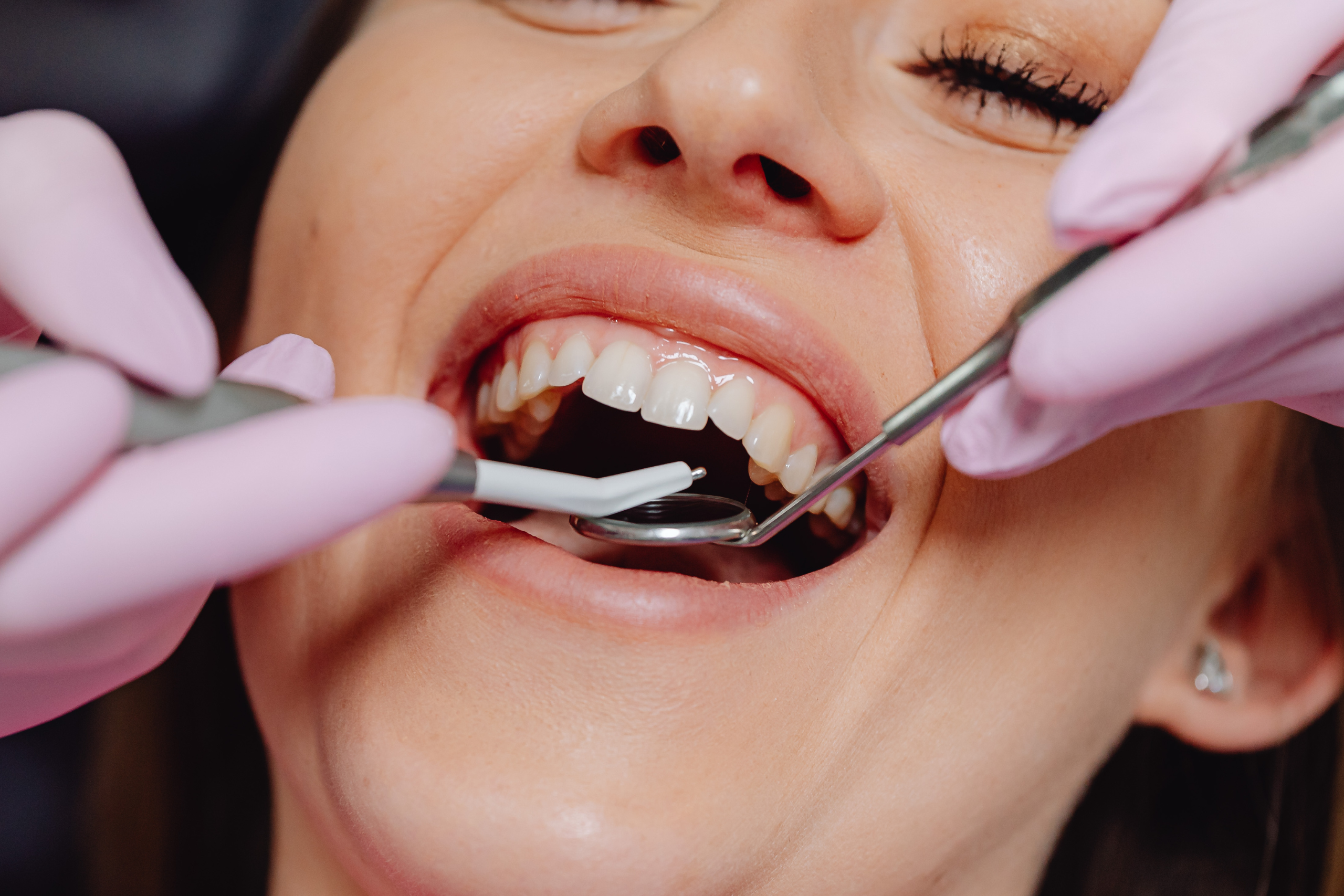When it comes to enhancing your smile, cosmetic dentistry offers several solutions to achieve that confident, radiant look. Two popular options are veneers and dental bonding, each with unique benefits tailored to different needs. But how do you decide which is right for you? In this blog, we’ll explore the differences between veneers vs. bonding, their pros and cons, costs, durability, and more to help you make an informed decision for your cosmetic dental treatment.
What Are Veneers?
Veneers are thin, custom-made shells, typically crafted from porcelain or composite resin, designed to cover the front surface of your teeth. Porcelain veneers are especially popular in cosmetic dentistry due to their natural appearance and durability. They’re ideal for addressing issues like:
- Discolored or stained teeth
- Chipped or cracked teeth
- Gaps between teeth
- Slightly misaligned or uneven teeth
The process involves removing a small amount of enamel (about 0.5–1 mm) to ensure a snug fit, followed by bonding the veneers to your teeth with a strong adhesive. This tooth restoration option is known for its long-lasting results and ability to create a flawless smile makeover.
Benefits of Veneers
- Natural Aesthetics: Porcelain veneers mimic the translucency and shine of natural teeth, offering a seamless look.
- Durability: With proper care, veneers can last 10–15 years or more.
- Stain Resistance: Porcelain is highly resistant to stains from coffee, tea, or red wine.
- Customization: Veneers are tailored to match your desired shade, shape, and size for a personalized dental aesthetics result.
Drawbacks of Veneers
- Cost: The cost of veneers can range from $800 to $2,000 per tooth, depending on the material and location.
- Irreversible Process: Enamel removal is permanent, requiring lifelong commitment to veneers or other restorations.
- Potential Sensitivity: Some patients experience temporary tooth sensitivity after enamel removal.
What Is Dental Bonding?
Dental bonding is a cosmetic dental treatment where a tooth-colored resin is applied to the tooth’s surface, shaped, and hardened with a special light. This versatile procedure is often used to fix:
- Chipped or cracked teeth
- Small gaps
- Discoloration
- Minor tooth reshaping
Unlike veneers, dental bonding requires minimal to no enamel removal, making it a less invasive option. The procedure is typically completed in a single visit, offering a quick and effective solution for minor imperfections.
Benefits of Dental Bonding
- Affordability: Dental bonding is more budget-friendly, with costs ranging from $100 to $400 per tooth.
- Minimally Invasive: Little to no enamel removal preserves your natural tooth structure.
- Quick Procedure: Bonding can often be completed in 30–60 minutes per tooth.
- Versatility: Suitable for minor repairs and aesthetic improvements.
Drawbacks of Dental Bonding
- Durability: Bonding lasts 5–10 years, shorter than porcelain veneers.
- Stain Susceptibility: Resin is more prone to staining compared to porcelain.
- Less Natural Look: While effective, bonding may not match the translucency of natural teeth as closely as veneers.
Veneers vs. Bonding: Key Differences
When choosing between veneers vs. bonding, consider these critical factors to determine which aligns with your goals for dental aesthetics and tooth restoration:
- Appearance
Porcelain veneers excel in creating a polished, natural look, making them ideal for comprehensive smile makeovers. Their ability to mimic tooth enamel’s translucency is unmatched. Dental bonding, while effective for minor fixes, may appear less lifelike, especially under certain lighting.
- Durability
Veneers are more durable, lasting up to 15 years with proper care, while dental bonding typically lasts 5–10 years. If longevity is a priority, veneers are a better investment.
- Cost of Veneers vs. Bonding
The cost of veneers is significantly higher, ranging from $800 to $2,000 per tooth, compared to dental bonding at $100 to $400 per tooth. Bonding is a more accessible option for those on a budget or needing minor repairs.
- Procedure Time
Dental bonding is faster, often completed in one visit. Veneers require multiple appointments, including consultations, enamel preparation, and fitting, which may take a few weeks.
- Invasiveness
Dental bonding is minimally invasive, preserving most of your natural tooth. Veneers involve irreversible enamel removal, which may not suit everyone.
- Maintenance
Both options require good oral hygiene, but porcelain veneers are more resistant to stains and chips. Dental bonding may need touch-ups or replacements sooner, especially if exposed to staining agents like coffee or tobacco.
Who Should Choose Veneers?
Porcelain veneers are ideal for individuals seeking a dramatic, long-lasting smile makeover. They’re best suited for:
- Severe discoloration not responsive to whitening
- Multiple aesthetic concerns (e.g., chips, gaps, and misalignment)
- Those willing to invest in a premium, durable solution
- Patients prioritizing a natural, stain-resistant finish
If you’re looking for a transformative change with lasting results, veneers may be your top choice in cosmetic dentistry.
Who Should Choose Dental Bonding?
Dental bonding is perfect for those needing minor repairs or a cost-effective solution. It’s ideal for:
- Small chips or cracks
- Minor gaps or discoloration
- Budget-conscious patients
- Those preferring a reversible, less invasive procedure
If you want a quick fix without breaking the bank, dental bonding offers excellent value.
Veneers vs. Bonding: Which Is Right for Your Smile Makeover?
Choosing between veneers vs. bonding depends on your aesthetic goals, budget, and dental health. Here’s a quick checklist to guide your decision:
- Budget: If cost is a concern, dental bonding is more affordable.
- Aesthetic Goals: For a flawless, natural look, porcelain veneers are superior.
- Durability: If longevity matters, veneers outlast bonding.
- Invasiveness: Prefer a non-invasive option? Choose dental bonding.
Time: Need a quick fix? Bonding is faster.
Consulting a skilled dentist is crucial to assess your teeth and recommend the best cosmetic dental treatment. They can evaluate factors like tooth structure, oral health, and lifestyle to ensure your chosen option aligns with your needs.
Cost Considerations and Insurance
The cost of veneers and dental bonding varies based on location, the dentist’s expertise, and the number of teeth treated. Since both are considered cosmetic procedures, dental insurance may not cover them. However, some plans may partially cover bonding if it’s deemed medically necessary (e.g., repairing a chipped tooth). Check with your provider and discuss financing options with your dentist to make your smile makeover more affordable.
Maintaining Your Veneers or Bonding
To maximize the lifespan of your veneers or dental bonding, follow these tips:
- Brush and floss daily to maintain oral health.
- Avoid biting hard objects (e.g., ice, pens) to prevent chips.
- Limit staining foods and drinks, especially for dental bonding.
- Wear a mouthguard if you grind your teeth.
- Schedule regular dental check-ups to monitor your restorations.
Proper care ensures your tooth restoration remains beautiful and functional for years.
Why Choose Chestnut Ridge Dental for Your Smile Makeover?
At Chestnut Ridge Dental, we understand that your smile is your signature. Our team of highly skilled and compassionate dentists specializes in cosmetic dentistry, offering personalized solutions like porcelain veneers and dental bonding to enhance your dental aesthetics. With state-of-the-art technology and a patient-centered approach, we craft stunning, natural-looking smiles tailored to your unique needs. Our expertise in smile makeovers ensures you leave our office feeling confident and radiant.
Ready to explore veneers vs. bonding for your dream smile? Schedule an appointment with Chestnut Ridge Dental today! Our experienced team will guide you through every step, ensuring you achieve the perfect balance of beauty and function.
FAQs About Veneers vs. Bonding
- How long do veneers and dental bonding last?
Porcelain veneers can last 10–15 years with proper care, while dental bonding typically lasts 5–10 years. Durability depends on oral hygiene and lifestyle habits.
- Is the veneer process painful?
The procedure is generally painless, though some patients may experience mild discomfort or sensitivity after enamel removal. Local anesthesia is used to ensure comfort.
- Can dental bonding be whitened?
Unlike natural teeth, bonding material doesn’t respond to whitening treatments. If discoloration occurs, the bonding may need replacement.
- Are veneers or bonding covered by insurance?
Most insurance plans don’t cover cosmetic dental treatments like veneers or dental bonding. However, bonding may be partially covered if it’s medically necessary. Check with your provider.
- Can I get veneers or bonding on just one tooth?
Yes, both veneers and dental bonding can be applied to a single tooth to address specific concerns like chips or discoloration.
- How do I know if I’m a good candidate for veneers or bonding?
A dentist will evaluate your oral health, aesthetic goals, and budget to recommend the best option. Schedule a consultation to discuss your smile makeover needs.





